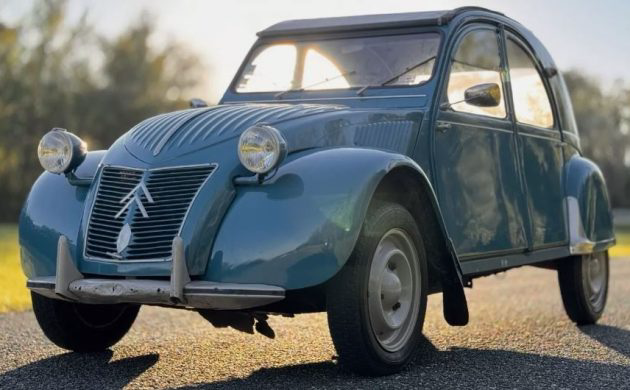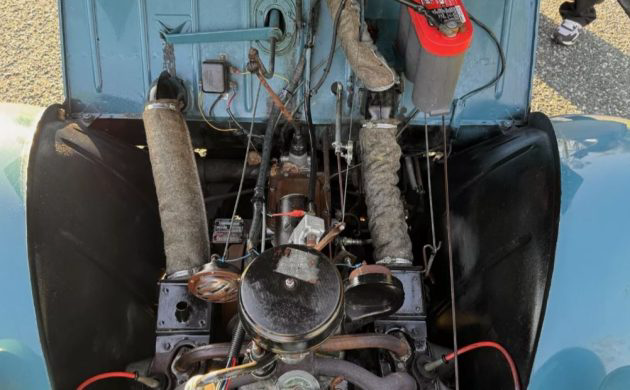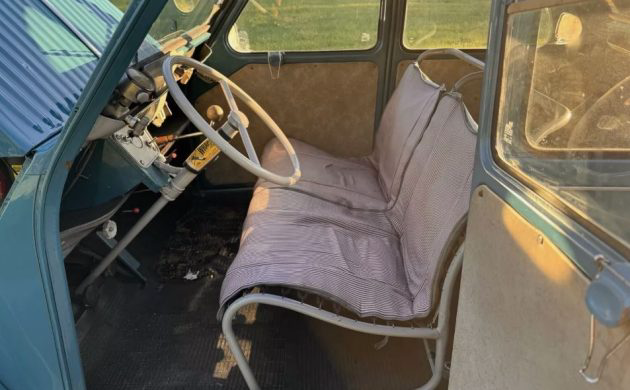The Citroën 2CV (Deux Chevaux for “two horses”) was originally aimed at helping farmers replace Ol’ Dobbin with a conveyance that ate less, traveled twice as fast, and carried four people. With a soft suspension that traversed planted fields without disturbing the car’s contents, it was the brainchild of Pierre Boulanger, Chief Engineer at Citroën. The company produced a prototype in 1937, along with about 50 useable examples. These were crafted of aluminum and made use of a two-stroke water-cooled engine. Christened the Très Petite Voiture – or “very little car”, rudimentary construction meant the TPV was cheap to buy and cheap to run. When WWII intervened, the same engineers who built the little car destroyed or hid every copy they could find – and the machinery used to make them – to prevent enemies from stealing the idea. Only five examples are known to have survived the war. Once Europe stabilized and began to rebuild, Citroën returned to its farmer’s car project, modifying its architecture to include two headlights, an air-cooled engine, and a steel body. Finally ready for its moment on stage, the Deux Chevaux was exhibited at the 1948 Paris Motor Show. Production ran through 1990 and amounted to some 3.8 million examples – but that was only half the story: on its introduction, orders swamped production, resulting in a multi-year waiting list. Today’s 1960 Deux Chevaux comes from single-family ownership and is listed here on eBay in a no-reserve auction with bidding at $4350.
Early 2CVs had a 375 cc flat twin engine rated at about 9 hp but taxed at 2 hp- thus the “Deux.” The electrical system ran on 6 volts, and the suspension was an ingenious set of springs that achieved self-leveling while minimizing body roll. The manual gearbox supplied four gears, with the fourth acting as an overdrive; top speed was about 40 mph. By 1955 the engine displaced 425 ccs and made 12 hp. An increased compression ratio in 1956 produced another fractional horsepower. It took until the late 1960s for the engine size to increase again, but even to the last car made in 1990, horsepower remained minimal, and top speed was restrained. This car’s odometer has clocked just 15,000 miles from new. No, that battery is not positioned correctly.
As tidy and charming as the interior is – with its white steering wheel, metal-framed seats, and striped upholstery – it’s also the epitome of austerity. The door latches are levers, that wire contraption on the door panel opens the lower half of the window, insulation- what’s that? no armrests, no seat adjustment … but the top rolls open! The seller notes that all the lights work, as do the gauges. A jack, lug wrench, and the spare are still in the trunk. Speaking of which – the Deux Chevaux didn’t provide an opening trunk lid until 1958.
From the rear, the little Deux Chevaux looks like a snail crossing the road – in a charming way. Other than the modern Optima battery, which can be changed, the one characteristic of this particular car that will keep it out of the survivor class at a local concours is a repaint executed twenty years ago. Otherwise, the mileage claim is entirely believable. These cars are easy to work on, parts are available, and the entry price should remain reasonable. For a first-time collector, this whimsical French find offers a great entrée to the fellowship of vintage car ownership.









Howard A- where are you? I can’t wait to hear your take on this! 😉
The battery is in the correct place; it’s just not the correct battery! Too big.
You can fit a 602 without changing the look of the thing; Amis were fitted with a parallel-port 602. Later 2CVs and Dyanes had crossflow heads and the manifolds look very different.
Such an original and correct 2CV, they are almost impossible to find in this condition. 1960 is the final year of the old 1950’s style hood.
I was inclined to start bidding but then the pictures from underneath gave me pause. It’s looking quite worrying. Of course an in-person inspection might say that it’s mostly just crusty dirt, but having owned a few 2CV I suspect that this one will need a new chassis. Not too difficult to do, but expensive and time consuming.
One small comment – it’s the blocky black thing beind that “wire contraption” that opens and locks the window, and the wire thingy folds out to hold the window in a slightly open position. The later cars did away with that and only had a locking pin that can hold the glass fully open.
I may have to bid on this…showed it to my wife a moment ago to soften her up! Then we could start a French Revolution when we attend a local car event…she could drive this and I’d drive our ’61 Renault Dauphine!
Stay tuned…we’ll see what happens!
You need to get “SHELBY” license plates for your Dauphine…
“……minimizing body roll.” Really?
In the college town where I used to work, I’d see one of these running around from time to time–maroon and black. I think it was somebody’s daily driver. Quite a surprise! It’s the only time I’ve seen one in person.
I’ll bet some Frenchman visiting Disney World buys this and ships it back to France because it’s better than what’s left over there!